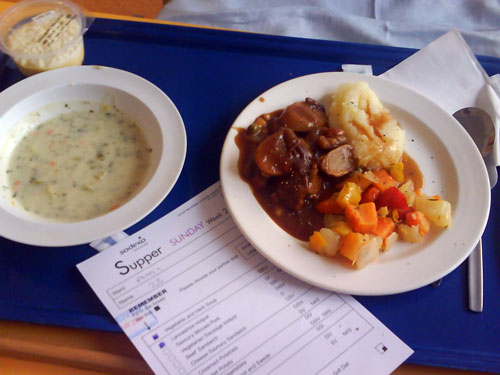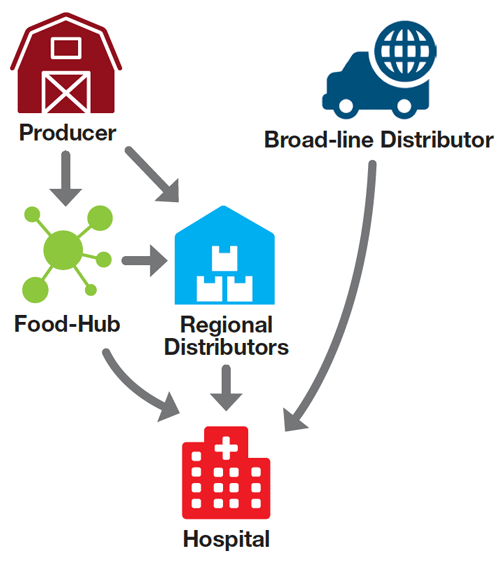On this Page

Introduction
In Virginia, there are 92 acute care hospitals, with over 18,000 staffed beds (https://www.ahd.com/state_statistics.html). Urban hospitals (100+ staffed beds) have much higher patient volumes, as compared to rural hospitals (<100 staffed beds), thereby necessitating a higher number of meals served daily. Hospitals can vary greatly in terms of food service operations. Some hospitals prepare foods on site, while others prepare food off-site and ship it in, therefore only needing to heat and serve the food. Additionally, many hospitals have cafeterias or snack bars for visitors and staff.
Another level of complexity with hospitals is how they manage their food service. Some hospitals are self-operated, while others are managed by food service contractors—companies like Sodexo, Inc., Aramark Corp., and Compass Group North America. Add to this complexity the fact that many larger hospitals are in a group purchasing organization (GPO), which oversees all food procurement, typically working through broad-line distributors. These corporate contracts provide a consistent, reliable supply of food that meets specific sanitary and safety standards, often including rebates for large volume purchases.
Survey Findings
Thus, while there is a growing trend for patients desiring more fresh local produce, even food service directors wishing to purchase from local producers often find it challenging, if not impossible, to do so. It is no surprise this market represented the most complex sector, making it very challenging for a local producer to access and develop a fruitful business relationship. In fact, the low rate of responses in our market research were due to limitations in finding points of contact at these institutions, suggesting the complexity and hierarchical management levels in place regarding the procurement of produce. Respondents strongly emphasized the necessity for mandatory adherence to food safety requirements—in fact, GAP certification was essential, as we liability insurance. While all respondents reported that they would increase local procurement if more local producers could meet requirements for food safety, they also stated that consistency of volume and deliverability were often constraints faced with local producers. Given the necessity of these large institutions meeting these needs and maximizing the value of every dollar, primary channels for local food procurement included regional distributors.
Purchasing Priorities & Barriers
Priorities
- Quality
- Food Safety Certification
- Availability
- Product Variety and Diversity
- Proximity of Producer to Buyer
- Delivery Capabilities
Barriers
- Corporate Requirements/ Policies for Food Safety Not Met by Growers
- Cost of Product
- Insufficient Volume of Product
- Lack of Intermediaries (Food Hubs, Brokers, etc.)
- Product Consistency (Quality, Size, Ripeness)
- Delivery Capabilities (Timing, Flexibility, etc.)
Recommendations
- Hospital food procurement is one of the most complex purchasing systems, with an extensive hierarchy of management, personnel, and policy hurdles. Recognize that the person responsible for food procurement may not be flexible in their purchasing capabilities due to stringent corporate policies.
- Given the target population is immune-compromised, best on-farm food safety practices are critical! Third-party food safety certification is likely mandatory to access this market sector.
- Be open to supplying rural hospitals, since smaller institutions may have less hurdles, thereby making it easier for local farmers to tap into these smaller hospitals.
- Another consideration is whether or not food is prepared on site, or brought in ‘ready-to-eat’. Typically, ready-to-eat produce is procured from broad-line distributors or processors. Further, ready-to-eat food requires another entire level of food safety considerations due to the processing steps.
- Given the complexity of hospital systems, it can be challenging to find contact names of pertinent personnel using a simple google search. The possibility for a direct relationship with a hospital can be slim; therefore, you will likely need to work through an intermediary such as a local aggregator or food hub. These entities often have established relationships, and can also provide food safety verification and the minimum volume of product needed. In some cases, local aggregators may even go through a larger distributor who is servicing the institution.
- If personal contact is possible, consistent communication with the hospital purchasing personnel is crucial. Building personal relationships will vastly increase your opportunity to establish successful business relationships.
- Whatever the relationship, remember your delivery capabilities and product consistency are vital!
Producer Checklist
- What is the size of the hospital? Is it a private hospital or part of a larger corporate structure?
- Have you considered using a local food-hub or other intermediaries to be able to tap into this market? In many cases, selling directly to a hospital is impossible since they may only go through broad-line distributors. If this is the case, check into regional possibilities of wholesale aggregators and distributors, who may already have established relationships with hospitals.
- If selling to hospitals is a possibility, have you considered how you will get in touch with the right person in regards to selling to a hospital? Often finding the key point of contact is very difficult, so you may need to tie into existing local initiatives that are trying to provide an increased amount of locally sourced produce.
- Since the majority of people receiving your produce have a weakened immune system, have you obtained and are you maintaining third-party food safety certification?
- Is a minimum comprehensive liability insurance required? If so, how much?
- Are you able to meet the volume demands of the hospital? If not, can you go through an aggregator, or are there smaller rural hospitals that may be more inclined to purchase smaller volumes of produce?
- Are there are food safety requirements such as needing to have a HACCP (Hazard Analysis and Critical Control Point) plan implemented in your operation?
- Are you able to be punctual in terms of delivery, should you choose to transport your own produce?

Helpful Resources
Accessing Virginia’s Hospital Market Sector: Fresh Produce Food Safety Considerations Factsheet
American Hospital Directory
Individual hospital statistics for Virginia (2000-2020).
Farm to Hospital Toolkit
This twelve-part document contains tools that farmers, ranchers and hospitals can use as they work to increase direct hospital purchases from local farmers.
Farm-to-Healthcare Institution Tool Kit
This Rodale Institute resource is tailored to healthcare and hospital executives and administrators, food service providers, and other institutional leaders and is designed to provide step-by-step guidance on how to create a successful farm-to-institution model, with an emphasis on health-focused institutions.
Farm to Institution: Healthy Food in Health Care
Learn about how hospitals, nursing homes, retirement communities and other health care facilities across New England are serving local and regionally grown food, hosting farmers markets, prescribing their patients farm-fresh food, growing on-site gardens and promoting healthy eating.